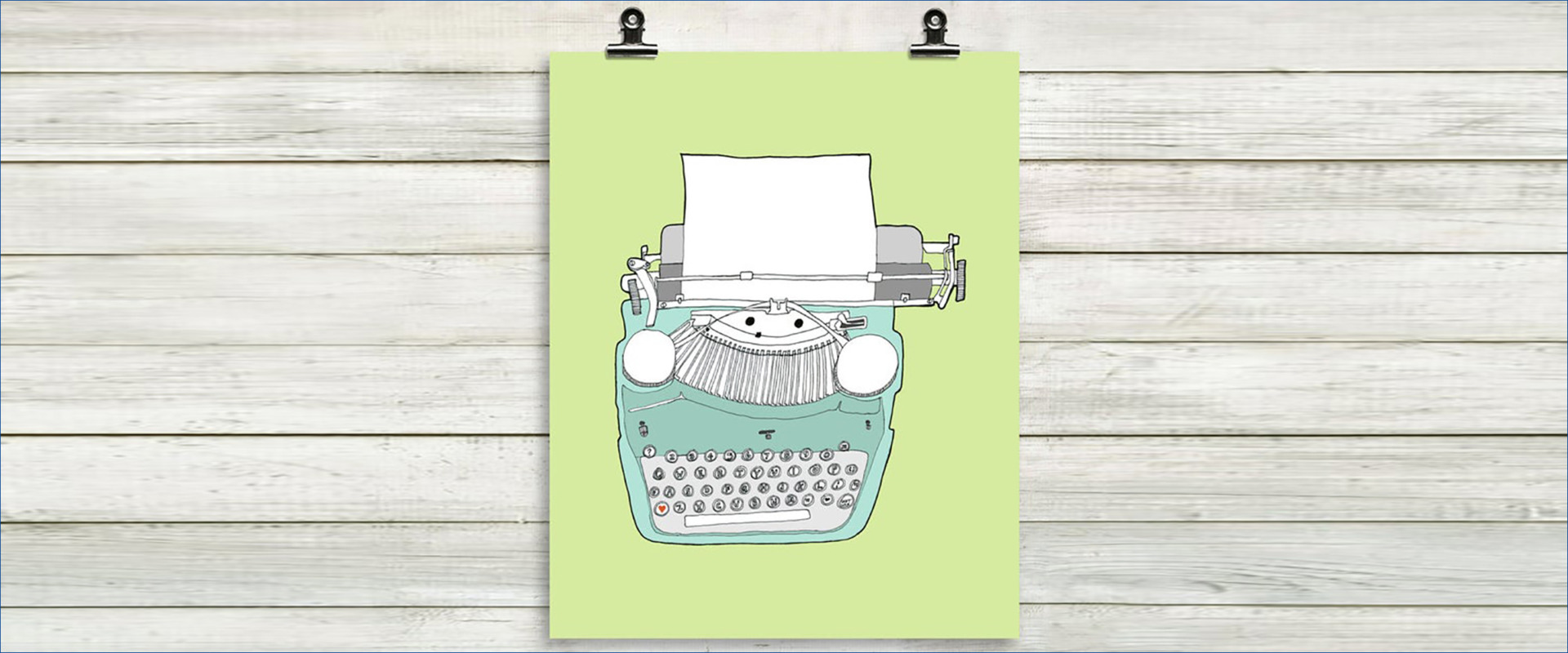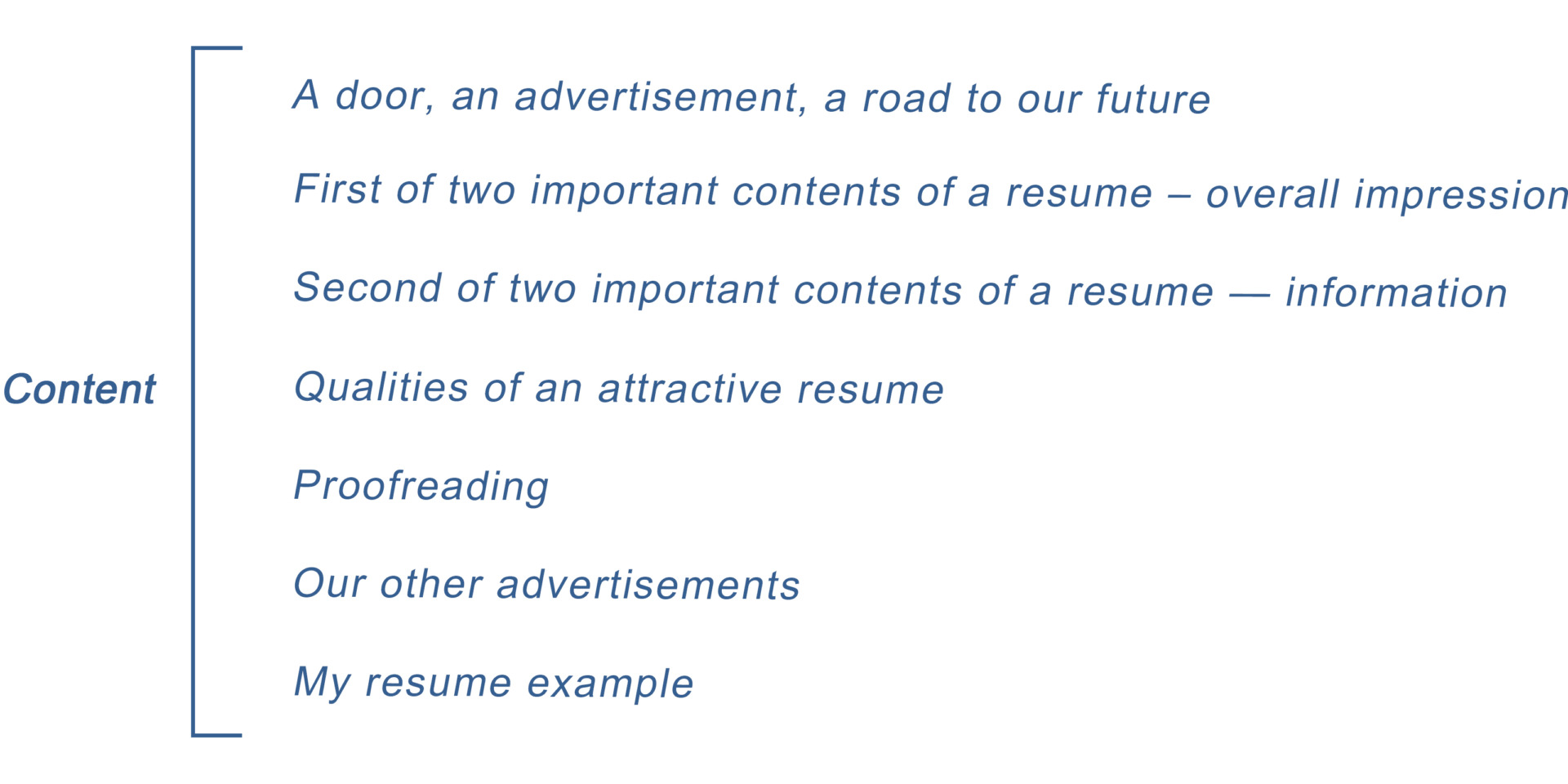An attractive resume
Virtual coffee with a student 2021-03-08


1) A door, an advertisement, a road to our future
A resume is a door, an advertisement, a road to our future. In our lives, we spend much of our time in uncritical activities – for example, leisure, daily routine. However, in rare instances, all of us, no exception, will come upon critical life junctions. Practically all of us will have the experience of being admitted to a school that will shape the rest of our lives, meeting a person who becomes our spouse, finding a job that becomes our lifetime devotion.
A resume is not an uncritical routine like most of our lives. It belongs to the class of critical activity that opens a sharp change to our future lives.
Some people may mistake a resume as part of inconsequential routines in their lives. Unfortunately, in this way they treat their resume as a common run of the mill. A typical example is resume templates easily available everywhere. Employers read hundreds of resume templates, the resume and the person who repeats it will be treated as such by the employer – insignificant. The person who writes his/her resume as inconsequential routine may not be aware, but he/she is unconsciously throwing his/her good future away. In fact, this happens very often.
In contrast, there are people who are consciously aware of what they do. They know what they are driving at, they find out how to do it, many times through hard effort. Because of their consciousness, they have a good chance of achieving what they want in life.
As is noted, a resume is a door to a person’s future.
2) First of two important contents of a resume – overall impression
In any presentation, for example a movie or a piece of music, or a resume, there are two sides to the content. One is the actual content – the movie story, music message, resume information. The other side is the presentation’s overall impression to the audience or reader. The overall impression is not itemized facts. It is an image the audience retains in the brain. Though an impression may have nothing to do with the story, message, information, but because the audience form and remember an overall impression in the brain, impression is as powerful as the actual story, message, information.
An audience’s feeling about a presentation is vague, that tests a movie director-actor, musician and writer, but great movie directors-actors and great musicians have mastered general feeling, and know about its importance.
A resume is much simpler, but it is just as important to win the overall impression of a reader. To reduce a complex subject to practical simple terms, consider 4 steps.
— Be aware that the overall impression of a resume is important to an employer. Imagine the overall impression of the resume in your brain, and ask yourself what feels right and what feels wrong. Repeat this if you feel necessary (in fact many times).
— Make a resume come from you, not directly from a template. When something authentically comes from you, that is already the best overall impression.
— Type the resume with appropriate but generous spacing, spacing dominates over letters, white background, letter fonts dignified, letter sizes well thought out. Pages must look strikingly clean.
— Include impressive photographs whenever it helps to illustrate the writing. We should be aware that pictures tell a story much better than written words, and the colour of a colour picture captures the eye of a reader. But be careful when including a photograph:
1) The photograph must be impressive.
2) The photograph must be called for by the writing, the photograph must not be unnecessary.
3) Second of two important contents of a resume — information
Many publicly available resume templates contain the following sub-topics:
Career objective, technical skills, personal skills, education, achievement / responsibilities, pre-professional experience.
Do not blindly follow a resume template. A resume template substituted with your name and abilities is a resume an employer may discard, for the following reasons:
— An employer has seen hundreds of the same resume.
— Many resume templates overblow the attractiveness of an applicant, or include personal information that is irrelevant to the job. Instead of grabbing interested attention, such filled in forms might achieve the contrary, giving off a sense that the resume does not show the applicant’s true person.
In fact, all the information a resume needs can be neatly contained in 4 sections, presented in the following order:
1) Cover letter
2) Name, contact address, education
3) Summary
4) Experience
Cover letter
A cover letter is written last, when a resume is fully complete to your final approval after multiple considerations and editing, but it is placed at the beginning of your letter to an employer.
There are 3 purposes in a cover letter, the first is to say the reason of sending your resume.
The second purpose is the sparkle of the cover letter. In it, you write whatever you want to say that is not covered in the attached resume. In the following resume we will write only information about your profession, and will exclude all irrelevant information not about your profession. But any other matters you want to say, and will help the employer understand and like you, can and should be included in the cover letter.
The third purpose of the cover letter is to look forward to what happens after this letter is sent. In business communication, it is good practice not to leave all follow-up to the addressee, but always suggest a follow up. Do it politely.
Name, contact address, education
Name, contact address, education are simple names grouped under one heading at the beginning of a resume. That being precise, but this is the beginning of a resume, effort should be made to make this heading win attention.
It is the opportunity to include a personal photograph, and make the photograph your good advertisement. Instead of identity card photograph, choose the best photograph in a relaxed setting. The photograph must not be small and invisible, nor dominating. It should be impressive.
Summary
The Summary is placed after the resume Heading and before the Experience section, it is one or more short paragraphs that sums up your full professional stature. It is in fact a critical part of the resume. This concise section not only summarizes your professional experience, but importantly calls up your personal quality, and your career aspiration.
Experience
An applicant may have 3 different levels of experience:
— The applicant has professional experience related to the applied job,
— The applicant does not have professional experience related to the applied job, but has other work experience or community service experience,
— The applicant does not have any of the above.
But regardless of level of experience, these rules apply:
1) Experience is itemized chronologically, latest experience first, with name, year, short description of the experience,
2) If relevant and necessary, supplement the description with pictures or portfolio, but the pictures and portfolio must be relevant and necessary.
A person with professional experience may find it easier, stating professional experience straight forward.
For a person with no professional experience, he/she can list any experience in community service, or schoolwork achievement, these should be as relevant as possible to help the person build his/her profession.
At all different levels of experience, impressing the employer about your aspirations is important. Do it in the Summary.
4) Qualities of an attractive resume
When a resume finally lands at an employer’s desk, these are the things perhaps all employers would want to see:
1) The applicant has thought about and decided, what is critical information. He/she has provided the critical information, and left out trivial information.
2) The applicant has addressed what the employer wants.
3) The applicant shows outstanding quality.
4) The resume is clear at a glance.
In practical simple terms, when writing a resume and proofreading it, keep these 4 qualities in mind.
5) Proofreading
It is said that when U. S. president Lincoln prepared his speeches that become famous icons, he mulled endlessly what he was going to say for days, while he went about daily life. Another national leader who led millions of people, and wrote millions of words to inspire people, said that after he wrote an essay, he typically re-read the essay 8 to 10 times before publishing the essay.
A resume is not for the world, but it is a representation of a person, and represents the worth of the person. After we finish a draft of our resume, generally the draft is not ready for issue. We do need to review the draft, the review spread over days when we have refreshed thinking. When we have shaped the resume to a form we are comfortable it meets all our concerns, our feeling will tell us the resume is ready to be sent.
As a final proofread, see that:
1) The resume has solid content,
2) There is no grammar or typing mistake,
3) The resume has a beautiful look.
6) Our other advertisements
A resume is the beginning of our advertisement. To achieve what we want in life, our advertisement — let people know what we can do, and what we represent — continues after the resume. When we master our other advertisements, our achievement in life is on the horizon. The following matter because they lead to our achievements in life:
— How we look does matter, to other people and ourselves. It conveys our person. Make our hair and our cloths always managed and dignified,
— How we talk with people,
— Our understanding of people,
— Our management of problems in life,
— Continued updating of our worth.
7) My resume example
My resume is at the home page of this website, the page shown is only the home page of my full resume. Perhaps the example conveys what the words cannot express, pictures are better than words.
To the reader of this article, I wish you excellent career.